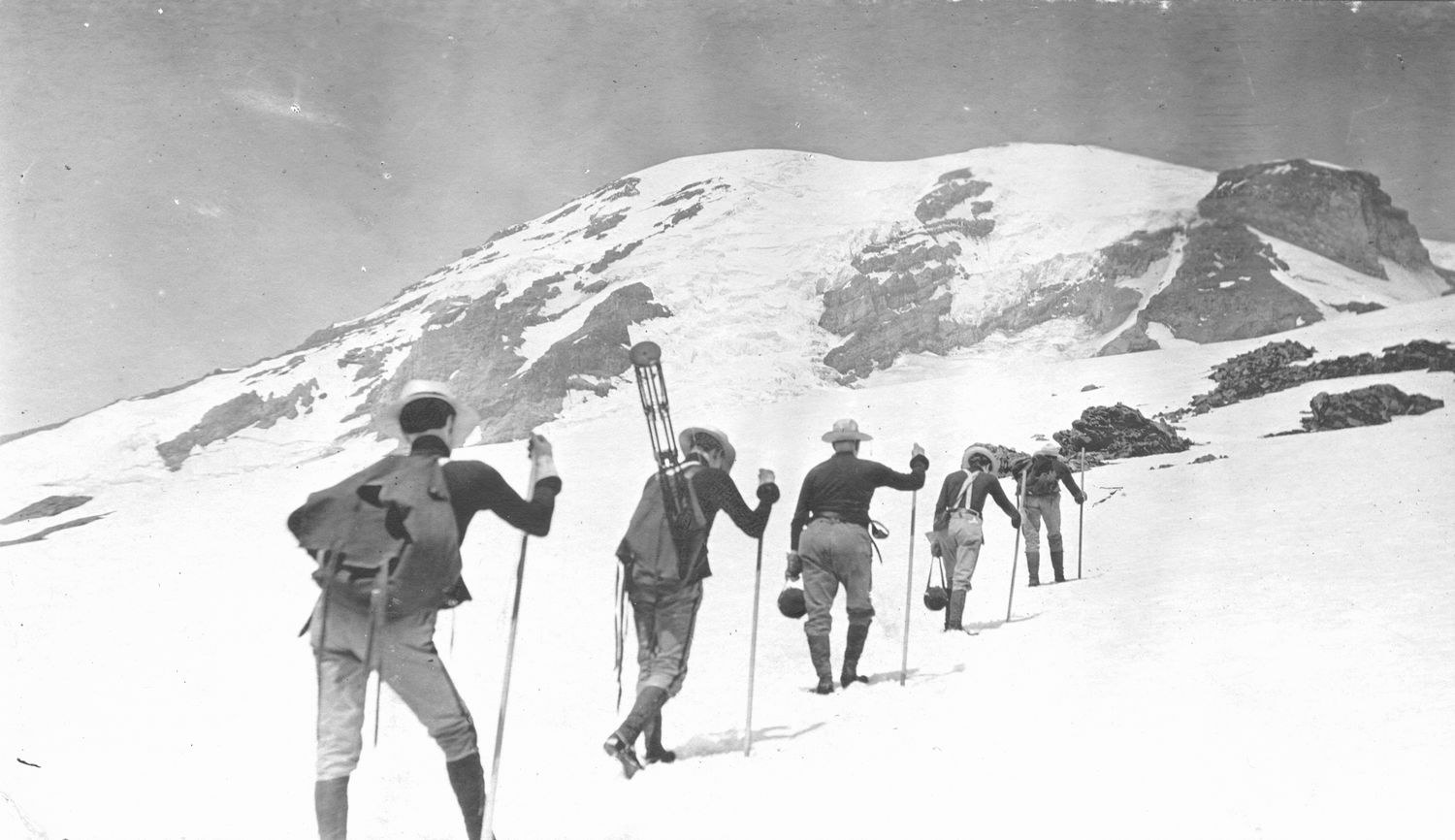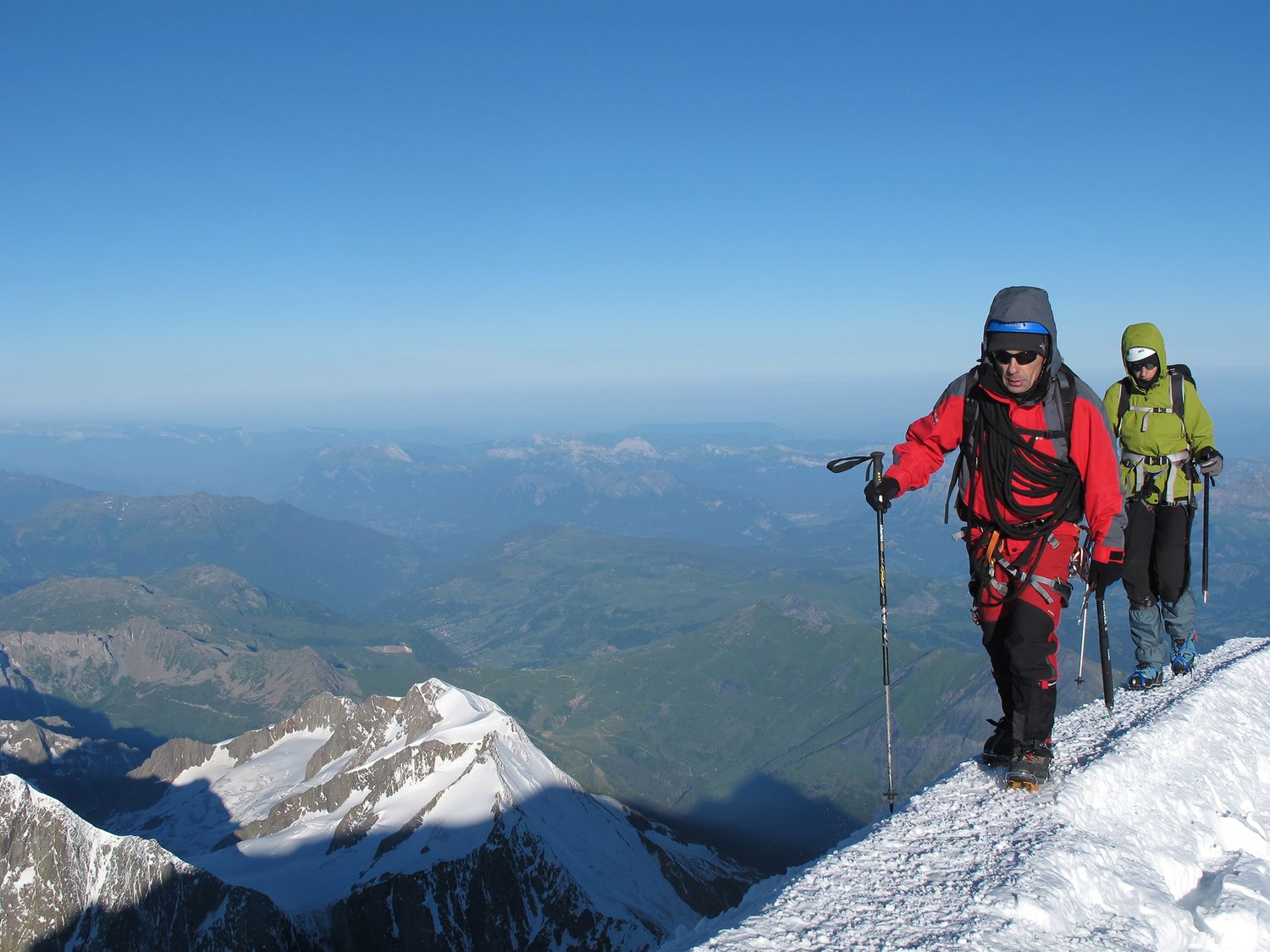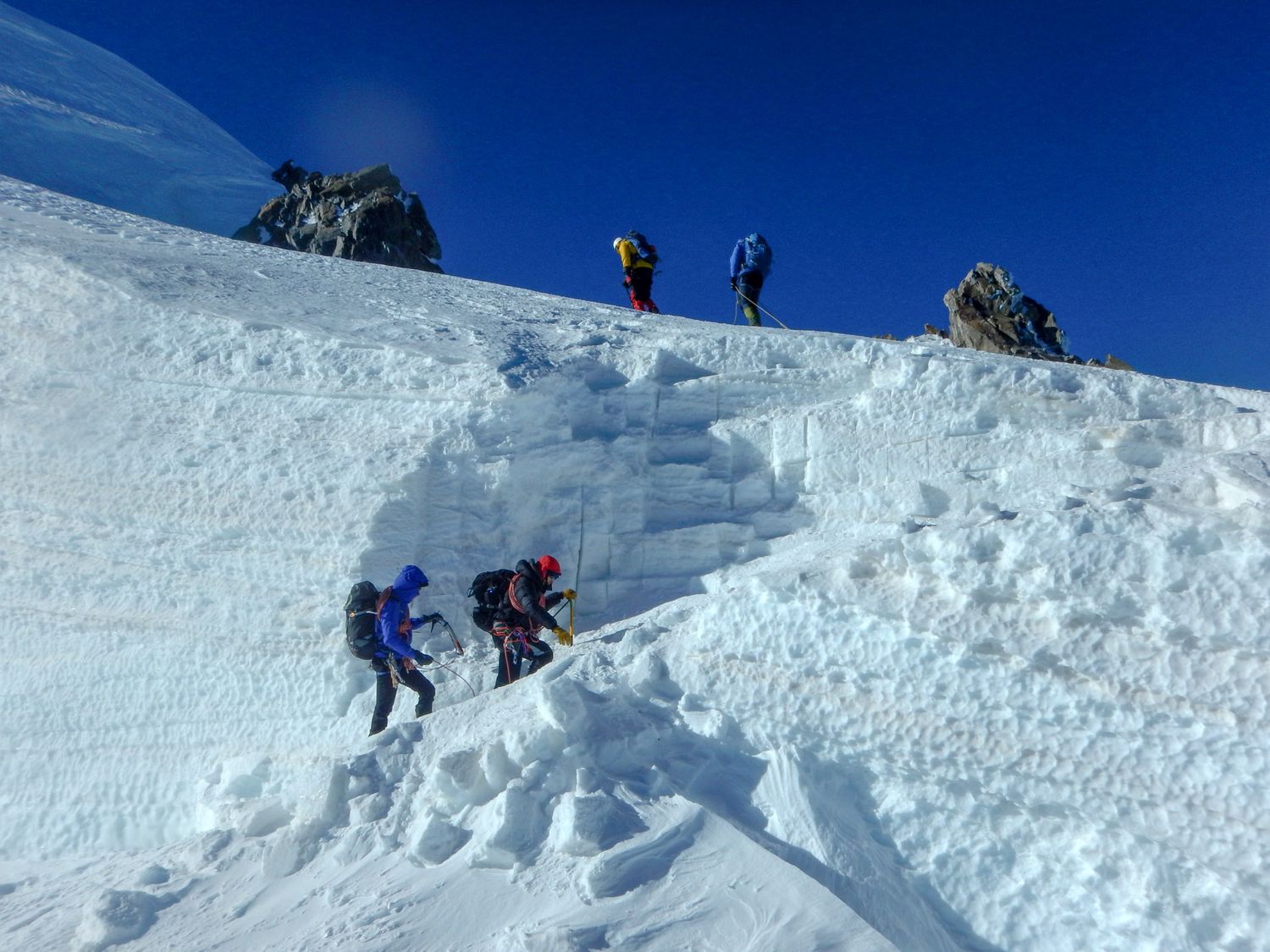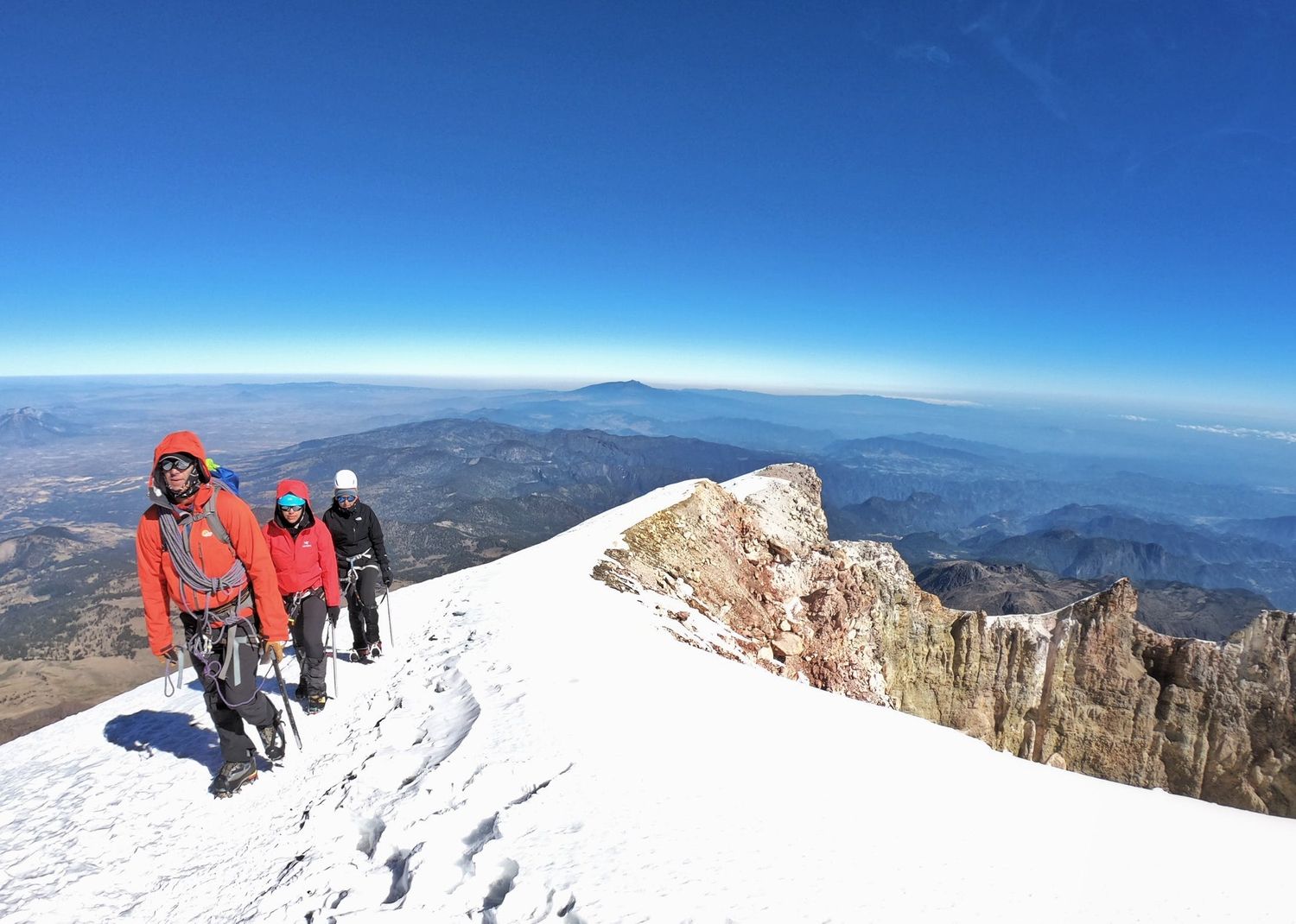What Are the Differences Between Mountaineering and Alpinism?
Like hiking and trekking, alpinism and mountaineering are two often-interchangeably used terms that have subtle but significant differences.
The goal of both alpinism and mountaineering is to reach the summit of a mountain, and both take place at high elevations in mountain landscapes.
Alpinism and mountaineering also require the same climbing techniques, including ice climbing, glacier travel and rock climbing. The key difference between alpinism and mountaineering is primarily how a climber arrives at the summit.
Keep reading: Five 6000ers to Climb in Nepal Next Spring
Both types of climbing have similar origins. The 1786 ascent of Mont Blanc by Michel-Gabriel Paccard and Jacques Balma is widely considered the first well-recorded example of alpinism.
This minimalist approach to climbing mountains continued to remain popular in the Alps and spread to other places with similarly-sized mountains, including the Pacific Northwest.
Alpine-style climbing later became associated with reaching the summits of the world’s tallest mountains. Reinhold Messner was the first to climb in the Himalayas quickly and lightly, relying on physical fitness and skill instead of large teams of guides and porters as previous expeditions all had.
What is mountaineering?

At its most basic level, mountaineering is the sport that brings a climber from the foot of the mountain to the top. Alpinism is a much more quick and lighter ascent.
Due to their length and often (but not always) more remote targets, mountaineering expeditions generally include porters to help haul gear.
Modern mountaineering is now defined as longer expeditions that require multiple ascents from base camps to high camps to find routes, place fixed ropes, haul gear and/or acclimatise. Multiple ascents and descents of a mountain also help climbers familiarise themselves with the terrain.
While this approach is generally better for novices to the sport, it entails certain risks and additional costs. Spending more time on the mountain increases the risk of experiencing inclement weather, avalanches and icefalls.
Since mountaineering expeditions tend to last for weeks or months, they also cost far more than alpine climbing expeditions with the need to bring more food, fuel, clothing and other supplies.
Climbing Mount Everest or Denali are classic examples of mountaineering expeditions. Both require a lengthy approach to base camp (albeit Denali’s is by air and Everests’ on foot) and involve setting up various camps over a series of days to weeks before making the final ascent to the top.
What is alpinism?

Some mountain climbing purists consider alpinism to be the more authentic form of climbing – on the mountain’s terms.
Climbers practicing alpinism take on a mountain in a single push. The expeditions last days instead of weeks or months, with climbers carrying less gear and not setting up fixed camps.
As a result, alpinism requires more experience, a higher level of physical fitness and more technical competence. Climbing skills are not taught during the expedition, meaning these trips are best reserved for experienced climbers.
Alpinism and mountaineering can be done on the same mountain. Many classic peaks for alpine climbing can be used as training grounds for less experienced climbers. However, alpine climbers will usually take different routes and spend less time at base camp than mountaineers, but both types of climbers reach the top.
Due to their differences, alpine climbing expeditions have less risk of exposure to inclement weather, avalanches and icefalls than mountaineering expeditions. Climbers also pass through the most dangerous sections of a climb the fewest possible times (i.e., the Khumbu Icefall on Everest).
However, there are risks of being unprepared for unexpected situations, and some mountains are simply too large and remote for an alpine climbing ascent.
Classic examples of alpinism include ascents of classic alpine peaks such as Mont Blanc and the Matterhorn, along with some of the most iconic mountains in the Cascade Range, such as Mt Shuksan.
While these peaks are more closely associated with alpinism, it is also possible to do alpine climbing on much higher mountains. The alpinists will acclimatise on another mountain before doing an alpine-style climb of a much larger mountain. K2 is a prominent example of this.
Top 5 Alpinism Destinations for the Spring
Now that the differences between alpinism and mountaineering have been explained, here’s a look at some of the top places around the world to head on your next alpine climbing expedition.
1. Mont Blanc

Rising high above the border between France and Italy, Mont Blanc is the crown jewel of the Alps.
Reaching 4,800 metres (15,800 feet) in elevation, Western Europe’s highest peak is the original home of alpinism and remains one of the top destinations for alpinists anywhere in the world. An estimated 20,000 people attempt to climb the peak each year.
Five main routes lead to the mountain’s summit, most of them starting from the French side. However, a couple of routes do climb up from Courmayeur, Italy.
Keep reading: Top 10 European Trekking and Mountaineering Destinations
The Goûter Route and 3 Monts Route are among the most popular from the French side, with the Aiguilles Grises being the most taken from the Italian side.
While none of these routes are overly technical and can be done in 2 to 3 days, climbing Mont Blanc is an intermediate-level challenge. The ascent is steep and requires mixed snow and rock climbing.
Hidden crevasses, rockfalls, and avalanches pose risks to climbers, so anyone heading to the summit must be prepared to deal with all three potential obstacles.
Quick facts:
- Location: France/Italy
- Elevation: 4,808 m (15,774 ft)
- Duration: 3 days
- Climbing season: June to September
- Estimated cost: $2,000
2. Matterhorn

Situated in the heart of the Alps in southern Switzerland, the Matterhorn is one of the world’s most distinctive mountains.
Rising to nearly 4,500 metres (14,800 feet) in elevation, the peak’s near-symmetric pyramidal summit makes it stand out from the rest of the impressive Swiss skyline.
Along with Mont Blanc, the Matterhorn is one of the most coveted peaks for alpinism. Its iconic north face is one of the three largest in the Alps and at the top of every advanced climber’s bucket list.
Eight main routes lead to the peak’s summit, but the Hörnli ridge route is the easiest. As a result, it is also the most popular but is a challenging undertaking with plenty of steep mixed rock and snow climbing sections.
Also known as Monte Cervino, the peak can be climbed from the Italian side. The Lion’s Ridge route is the most popular and involves a long and steep mixed climbing ascent of the southwest ridge.
Climbing the north face is an all-day affair for alpinists looking for a real challenge. The climb requires a 14-hour multi-pitch ascent of the rock wall. The whole climb is rated TD.
Quick facts:
- Location: Italy/Switzerland
- Elevation: 4,478 m (14,692 ft)
- Duration: 2 to 3 days
- Climbing season: June to September
- Estimated cost: $3,700
3. Orizaba

Located about 300 kilometres (185 miles) east of Mexico City, Pico de Orizaba is the tallest mountain in Mexico and its top alpine climbing destination.
The glaciated and dormant stratovolcano is the third-highest peak in North America and one of the Seven Volcanic Summits. Its crater’s unique and asymmetrical shape allows Orizaba’s glacier to exist at a far lower elevation than most other tropical glaciers.
Keep reading: Top Climbing Destinations in Mexico
Two main routes lead to the summit of Orizaba. The Jampa Glacier route is the more popular of the two and requires a long and relatively steep climb up the scree-covered flanks of the peak until arriving at the glacier.
The route requires some intermediate glacier travel techniques and traveling in a rope team. The most challenging part is traversing the rim of the volcano’s crater to reach the slightly higher southeastern side.
More advanced alpinists may instead take the tougher Ruta del Sur, which climbs the 10 pitches of the mountain’s southern face and requires advanced snow and ice climbing techniques to reach the top of the crater.
Quick facts:
- Location: Mexico
- Elevation: 5,610 m (18,406 ft)
- Duration: 2 days
- Climbing Season: November to May
- Estimated cost: $4,400
4. Mount Shuksan

Situated just south of the United States’ border with Canada, in the heart of North Cascade National Park, Mount Shuksan is one of the most popular alpine climbing destinations in North America.
At 2,783 metres (9,131 feet) in elevation, Shuksan is the tallest non-volcanic mountain in the Cascade Range and is one of North America’s 50 Classic Climbs.
Despite its modest elevation, Shuksan boasts plenty of excellent climbing options. Fourteen different routes lead from the base of the peak to the summit, each of which has several variations. This makes Shuksan perfect for climbers of every level.
Keep reading: Top 10 Mountaineering Destinations in the United States
The most commonly climbed and straightforward route is the Sulphide Glacier Route, which involves traversing a homonymous glacier until the climber reaches the summit pyramid. From here, there is a moderate scramble to the top.
Slightly more experienced climbers may opt to take on the Fischer Chimneys route, which avoids the glacier, instead involving some steep scrambling and mixed rock and snow climbing.
Other popular routes include Price Glacier, the Northwest Arete, and the North Face, which are more challenging than the two main routes and provide different types of mountaineering challenges.
Quick facts:
- Location: Washington
- Elevation: 2,783 m (9,131 ft)
- Duration: 3 days
- Climbing season: July to October
- Estimated cost: $1,000
5. Mount Hood

Oregon’s highest mountain is also the state’s premier alpine climbing destination. Mount Hood is located roughly 80 kilometres (50 miles) southeast of Portland and rises to just under 3,500 metres (11,500 feet) above sea level.
Despite its modest elevation and anecdotal evidence that a woman once climbed to the top in high heels, the peak is considered an intermediate alpine climbing challenge.
Due to the large circumference of the volcanic cone, more than 30 different routes lead to the summit of Mount Hood with a wide range of difficulties. However, only six of these routes are commonly used.
All the routes require technical glacier travel and mixed rock and snow climbing. Due to the high number of crevasses located on the peak's numerous glaciers, rope team travel is the norm for making an ascent.
The most popular way to get to the top is the Southside/Hogsback route, which approaches from the southern side of the mountain and requires climbing over the bergschrund of the glacier before ascending a series of snow chutes to get to the summit.
Quick facts:
- Location: Oregon, United States
- Elevation: 3,429 m (11,249 ft)
- Duration: 2 to 3 days
- Climbing season: April to mid-June
- Estimated cost: $600
Conclusion
While mountaineering and alpinism are very similar, the two approaches to climbing have some notable differences.
The common cliché is that mountaineers “lay siege” to the mountain, bringing plenty of equipment and supplies for a long stay. On the other hand, alpine climbers spend a few days climbing the mountain before returning to civilisation.
Once you have the requisite experience, put your mountaineering skills to the test on an alpine climbing expedition to one of the above locations!